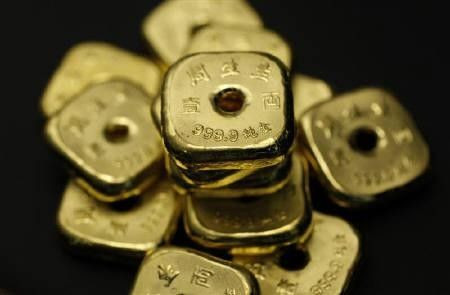Mystery Gold Buyers from China, India?

The World Gold Council's third-quarter demand report on Thursday showed central bank buying reached nearly 150 tonnes, far above most analysts' estimates, but the buyers were not named.
According to an analysis by Reuters of IMF data, previous buying patterns and delays in data reporting, the most obvious candidates are China and India.
Judging from the trend over the last two years, the purchasers are almost certainly nations with large external surpluses and big foreign exchange reserves, the bulk of which are in the emerging world, with nations in Asia or Latin American being the most likely.
According to Reuters calculations based on data from the International Monetary Fund, central banks have bought a net 208.9 tonnes of gold so far in 2011. The IMF data has identified buyers for a net 20.0 tonnes in the third quarter, creating a mysterious discrepancy of nearly 130 tonnes.
The WGC, an industry group, said it could not reveal the names of the buyers for reasons of confidentiality, which only added to the intrigue.
So far this year, the biggest buyers of gold have been Mexico, Russia, Thailand and South Korea. Other smaller, but nonetheless noticeable, buyers by virtue of their habitual absence from the market, include Colombia and Bolivia.
LARGE FOREX RESERVES
The list of the countries with the largest foreign exchange reserves is easy enough to come by. China, Japan, Russia, Saudi Arabia, Taiwan, India and South Korea are among the biggest.
Filtering through the reams of data the International Monetary Fund releases every month, however, is more complex and becomes a process of elimination, as many nations do not report changes to their gold reserves to the IMF on a regular basis.
This year's three top buyers all report on a monthly basis and include any changes.
So who has the firepower to buy that much gold and who doesn't report every month to the IMF? The sudoku that are the IMF's international finance statistics shows that in Asia, among the most likely candidates is China, which has the largest currency reserves, at $3.2 trillion, and reports its bullion figures with a two-month delay.
The snag here is China does not necessarily include the changes to its reserves when they happen. China said in April 2009 its gold holdings had risen to 1,054.4 tonnes from 600.3 through purchases that took place between 2003 and 2009.
The IMF's current batch of reserve statistics dates to September, which means the most recent data on Chinese holdings are dated June 2011.
The other two issues with China are firstly, Beijing has said it believes the gold market is too small and illiquid to be suitable for increasing the share of bullion in its portfolio of its vast reserves, currently at a mere 1.6 percent.
Secondly, China has hinted that were it to add to its reserves, it would do so by purchasing domestically-produced gold. China is the world's largest producer of gold and its second largest consumer, after India.
BEHIND CURTAIN NUMBER TWO
Enter possible buyer number two: India, which in 2009 reported a rise in its reserves to 557.7 tonnes after buying 200 tonnes from the IMF, in the single largest purchase by a central bank since at least 2002, according to the WGC.
India reports its figures with a one-month delay and, unlike China, tends to disclose changes when they occur. The most recent IMF figures for India are from August and any unreported third quarter activity would be expected by the end of November. India has foreign exchange reserves of $314.665 billion, of which gold represents around 9 percent.
Indonesia, which owns 73.093 tonnes of gold and has foreign reserves of around $113 billion, reports with a one-month delay, as does Philippines, with 128.7 tonnes of gold and $75.8 billion in total reserves, but the latter has sold a net 24.8 tonnes of gold so far this year.
South Korea has $310.98 billion in reserves and bought 25 tonnes of gold in May this year, its first purchase in three years. It reports with a two-month delay.
In the Middle East and North Africa, Saudi Arabia is the biggest holder of gold with 322.9 tonnes, with $500 billion in currency reserves. The gold market got a jolt last year when the IMF's data showed a 180-tonne rise in the country's holdings that Saudi authorities later said was down to just an accounting change that took effect in the first quarter of 2008 and has since said it is not looking to buy gold.
Moving on to Latin America, only Venezuela, which already owns the world's 15th largest official stash of bullion at 365.8 tonnes, reports with a delay to the IMF. It is in the process of repatriating its bullion holdings.
Brazil owns the largest foreign exchange reserves in the region, with $343.9 billion. But Brazil reports monthly to the IMF and includes changes. Plus, it has bought no gold since a 1,000-ounce purchase in February 2008, leaving its bullion reserves at 33.59 tonnes.
In Europe, Switzerland is busy amassing piles of dollars and euros through its interventions to curb the rise of the Swiss franc .
Switzerland has 1,040.1 tonnes of gold, making it the fourth largest European holder of bullion, after the Germany, France and Italy. It reports to the IMF with a one-month delay, but has disclosed changes when they take place.
Yet Switzerland is also unlikely to feature on the market's Most Likely Official Buyer of Gold list, given that, between May 2000 and September 2008, it sold chunks of its holdings after effectively removing the link between the Swiss franc and gold by referendum in 1999.
Will the mystery official buyer of gold please step forward?
© Copyright Thomson Reuters 2024. All rights reserved.





















